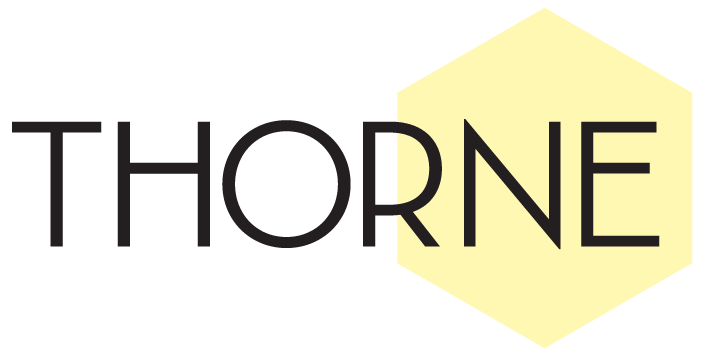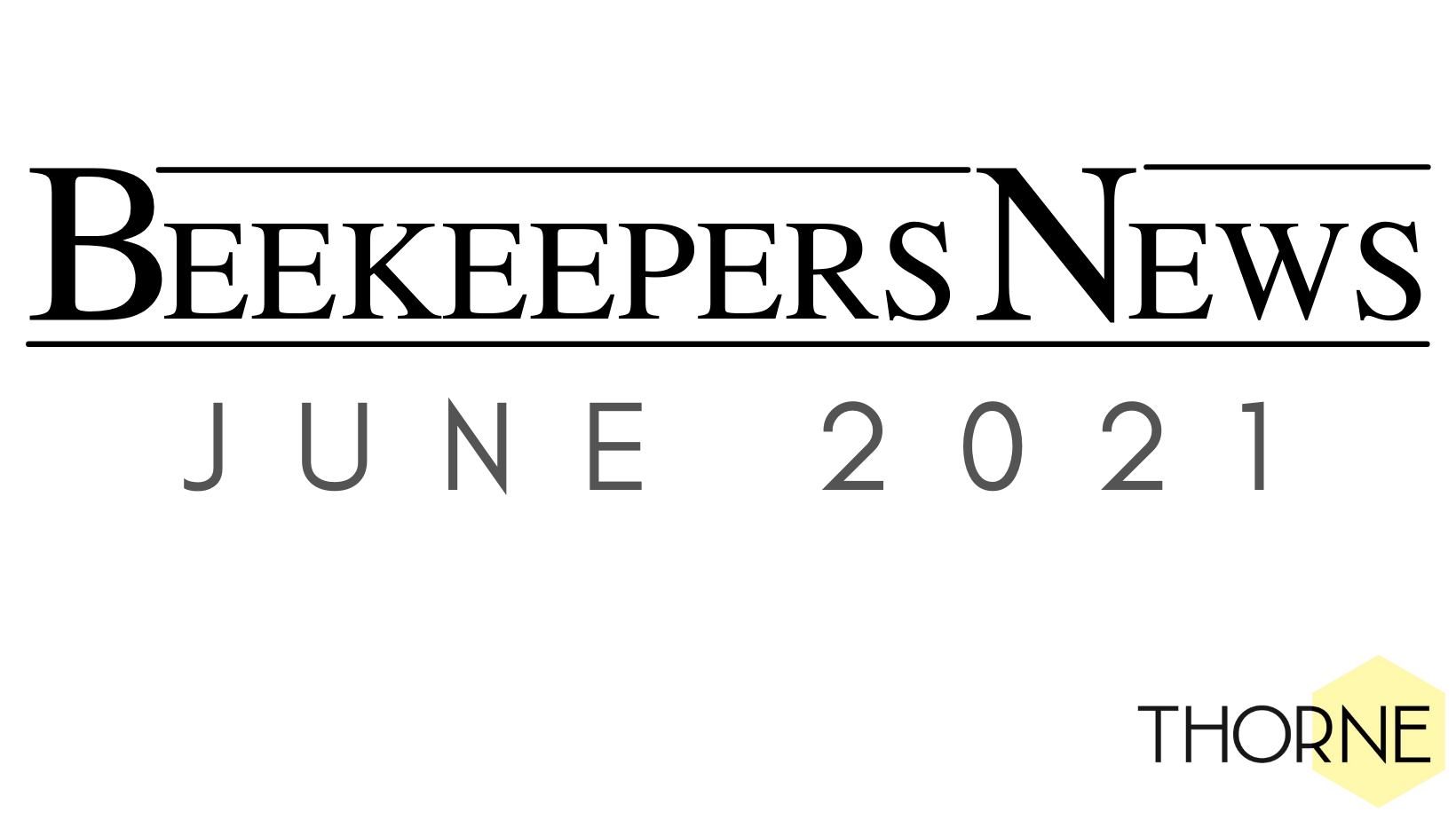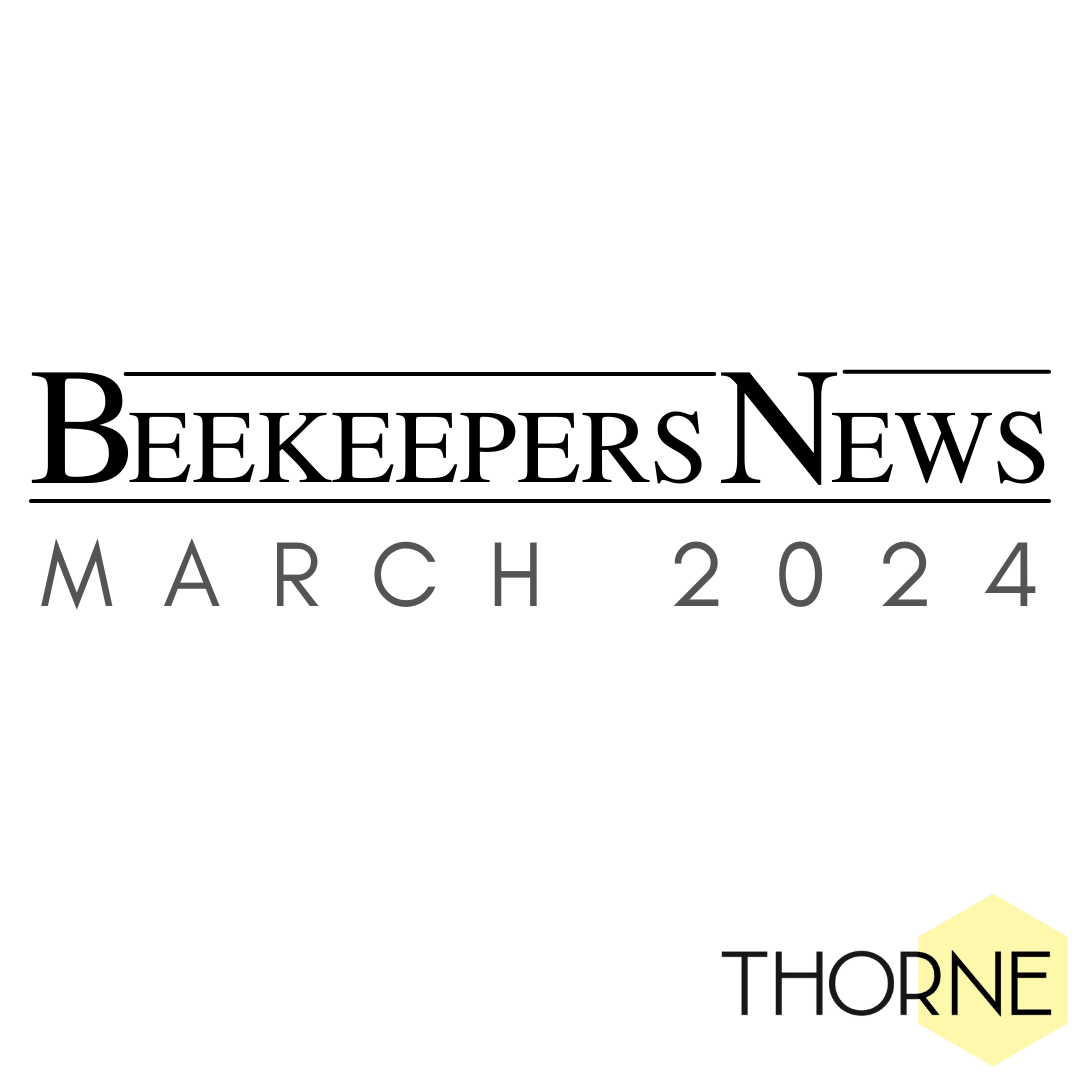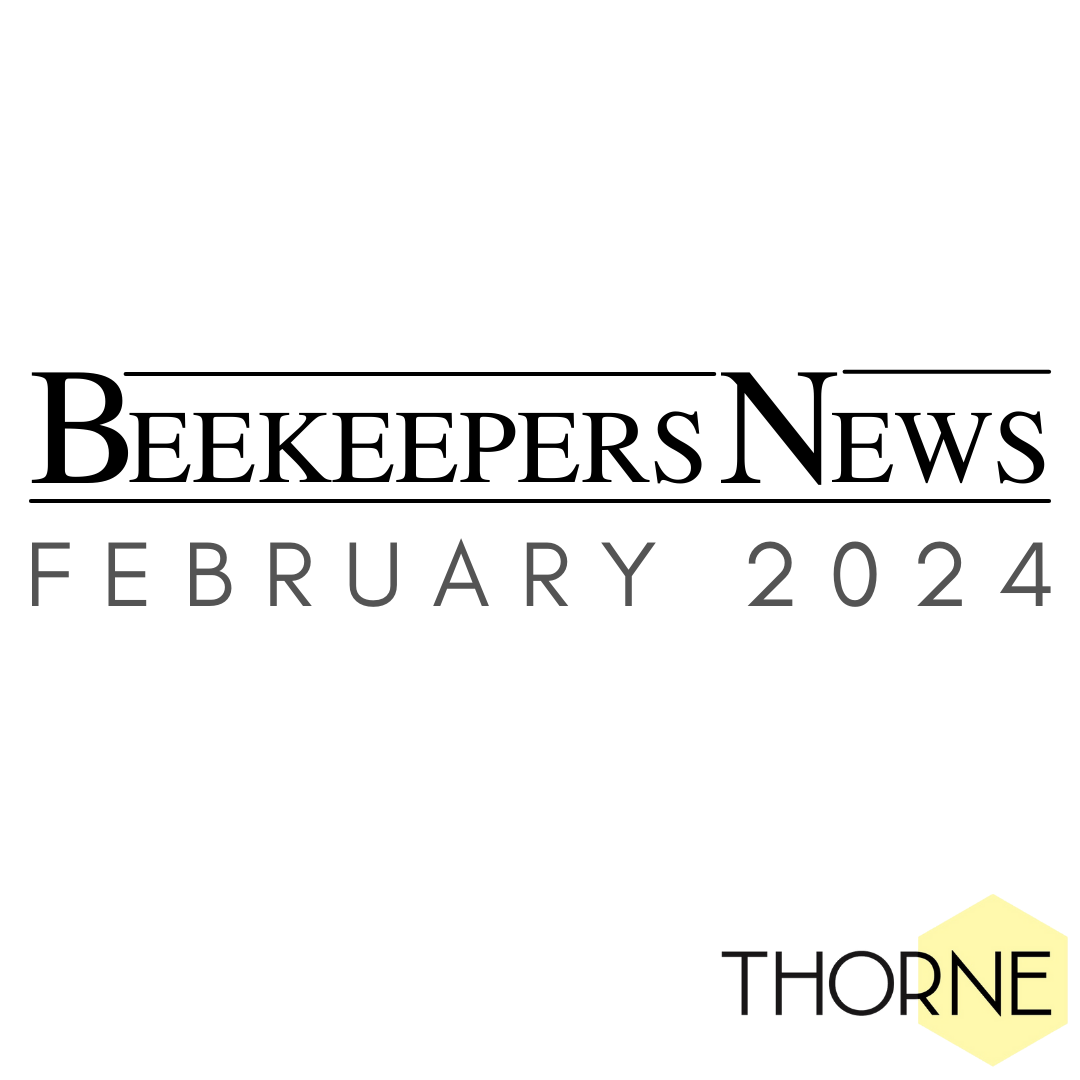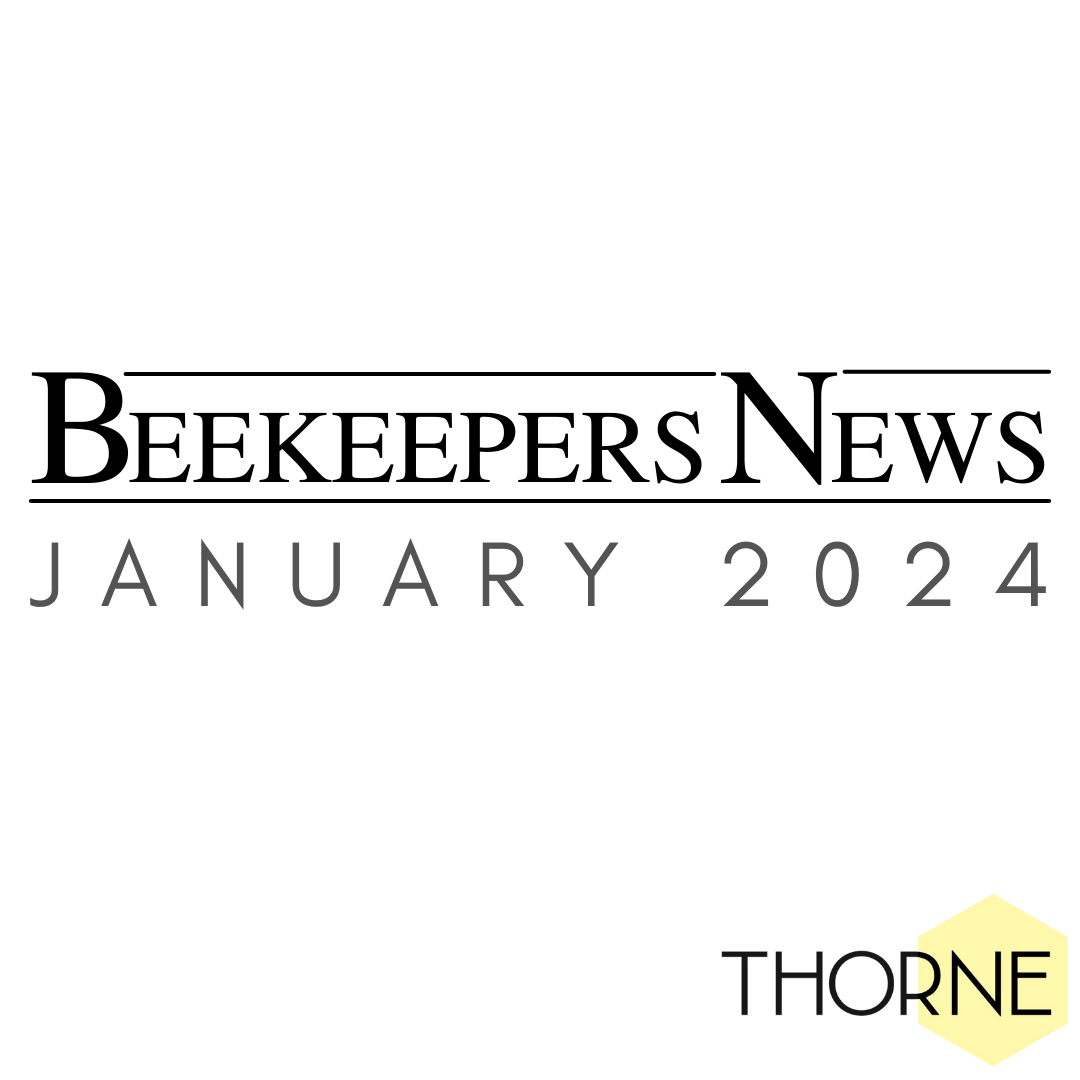It feels like it has rained every day since our last newsletter went out!.. But finally, the sun is out, the bees are out, and we are all busy here at Thorne!
To mark World Bee Day, which was on the 20th May, we announced our Hive Giveaway of 20 beehives to charities and organisations across the UK. We want these hives to help these different groups use nature, and bees, to improve mental health. We will be getting in touch with the successful organisations in the following couple of weeks and cannot wait to hear how they get on!
If you have not already, we would like to reiterate the importance of registering with BeeBase, and ensuring hive counts and locations are up to date on the system. You can do this on their website at www.nationalbeeunit.com
Check out the provisional dates for our Branch Sale Days at the bottom of the newsletter.
This month’s special offers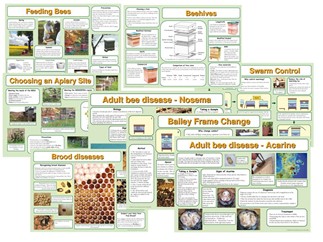
Educational Products
As courses start up again, this month we will be offering discount off some of our educational products. We have posters at 40% off Royle Posters, 30% off 3D Pictures and 20% off 3D Postcards and selected Loupes.
Shop them here at www.thorne.co.uk/educationsale
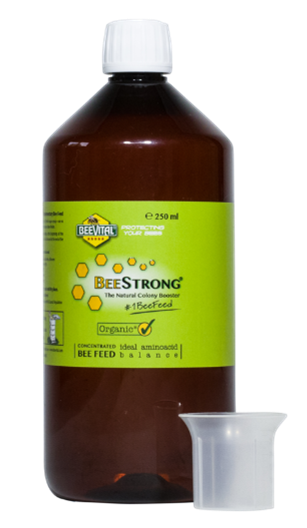 Bee Strong -
Bee Strong - £25 £20
Bee Strong is a bee feed that contains purified proteins. These proteins have been proven to fight pathogens such as chalk brood and bacteria such as European and American foulbrood.
Tests show that the natural antibiotic function of the proteins help prevent brood diseases.
Add 25ml to 1 gallon of sugar syrup.
- Feed in spring for help to kick start the colony.
- Feed in late summer to rear strong and healthy winter bees.
- Feed any time if needed for brood development.
Check out our website for more information.
Equipment Focus
RoBo Block
Made from 20mm aluminium profile, the same size as a regular entrance block. Developed, tested and manufactured at Rand, this is the only entrance block you will ever need. Opening must be at least 20mm high.
In its main position the block is either an entrance ventilator of 3mm holes on the right-hand side or an anti-robbing device of 6mm holes on the left-hand side, with a further row of 6mm holes off-set on the opposite side. Bees in the hive can find their way out and back again. Robbing bees or wasps find it difficult to negotiate both banks of holes. The adjustable alloy slide is used to close the entrance as required, exposing the ventilation holes. Also in this position, the slides can be extended outwards and tacked/screwed to the floor joists. In this position the hive will be completely closed and secure if you are planning to move it any distance.
For those keen to examine the pollen the hive is collecting, turn the block away from you through 90 degrees and expose a 6mm entrance slot on the left-hand side (this also acts as a mouseguard) plus a bank of 5mm pollen stripping holes on the right-hand side with an alloy slide to expose either feature. Below the stripping holes is a shallow, removable tray which collects the pollen samples. This will only need to be set to pollen stripping for a matter of minutes as samples will build up rapidly.
Shop RoBo Blocks on our website here – prices start at £12.25
Ask the Expert
Swarm attractants
I have yet to meet a beekeeper who has not lost bees through swarming. It is one of those things that we know bees do, but sometimes in the rush of the season we just do not get round to doing our swarm control in time. We come back to find our beloved queens have disappeared along with a good majority of the bees.
Swarm attractants are useful in this respect as they can be used to keep a swarm from flying out of the apiary. They are also helpful in catching swarms from elsewhere that are passing or those that have been hanging temporarily in a tree nearby.
 Swarm wipes
Swarm wipes
These are just like a cleansing wipe and come impregnated with essential oils to attract swarms. The sachet containing the wipe just needs to be torn or pierced and then hung in a suitable place such as a tree, a post or the inside of a bait hive. Before use, the wipes should be kept in the fridge.
For full instructions, please click here.
Swarm lures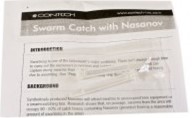
These are small phials of synthetically produced pheromone which attract swarms. The phials come with a small hoop, through which a nail can be placed, attaching it to a frame in a bait hive or other suitable place. Before use, the lures should be kept in the freezer.
Comb
Old comb can also be used to encourage swarms into bait hives. Bees seem to like to set up home where they know other bees have also lived. This could be clean, old frames or just a few pieces of drawn comb. Ensure this is disease free first of course! If there is a lack of comb, try using propolis. This may not be quite as successful but may help to convince a passing swarm that other bees have lived there before.
Bait hives
This is basically a spare box or hive, normally placed in an existing apiary. All the products above can be used in a bait hive to encourage swarms to move into it. Make sure this box is big enough to house the size of swarm you wish to collect. If you put a small nuc box out, you may catch some bees, but it is more likely to be a cast - do not expect a huge primary swarm to set up home in a small box.
These are all ways to encourage swarms to go into a box of our choosing. However, as with most aspects of beekeeping, be prepared for them to surprise you…
Happy swarm collecting!
Blog
May
Well, this month has been a tricky one! We have seen the worst weather May could possibly have brought us – wet, cold and wind. Not spring-like at all. It has been the worst May we have seen in many, many years. Most of the colonies are much further behind than they would normally have been at this time of year. Despite farmers here still growing oil seed rape close by, the bees have been short on stores and we have reluctantly had to feed them to prevent them from starving.
We have still managed to take off some nucs however, for customers across the UK, although not in the usual numbers for this time of year, as of course, our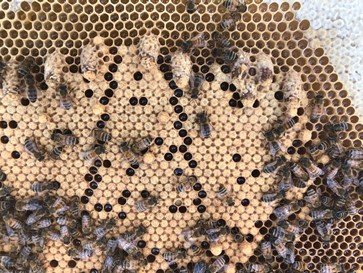 priority is the welfare of the bees. You can see here a frame with lots of emergency queen cells. After we take nucs off it is imperative that we go through the hives soon after to stop the colony from creating lots of these cells and swarming or casting off with virgin queens. The weather has been so bad that we have struggled to do this as effectively as we normally would, but fingers crossed June is an easier month for us.
priority is the welfare of the bees. You can see here a frame with lots of emergency queen cells. After we take nucs off it is imperative that we go through the hives soon after to stop the colony from creating lots of these cells and swarming or casting off with virgin queens. The weather has been so bad that we have struggled to do this as effectively as we normally would, but fingers crossed June is an easier month for us.
With the drastic change in temperature right at the end of the month, we were met with swarms that came out on the very first sign of good weather, despite not showing the normal signs of wanting to swarm. Fingers crossed we caught them all, but inevitably some get away. Better weather has meant more foraging, and the bees have been very busy collecting nectar for the colony. We know this because as the frames are taken from the hive to be looked at, the nectar drips from the comb. We do our best to avoid dripping too much as we know how precious it is to the bees at the moment. The other thing that they have been busy collecting is pollen. This is extremely important for the rearing of bee brood because it is basically pure protein and therefore essential to their growth. As you can see here, there is a nice variety of colours, meaning they are beginning to forage on a number of different plants.
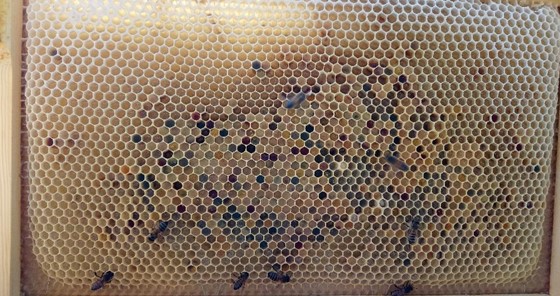
Looking at the forecast, the sunny days are set to continue up here in Lincolnshire and we really hope they do!
Book review
Variations on a Beehive
Compiled by Patricia Nelson, published by Northern Bee Books ISBN 978-1-912271-50-4 £22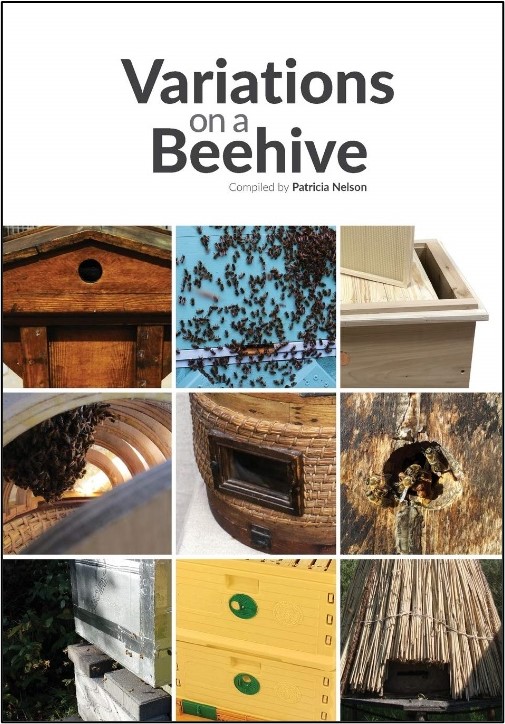
This book is an unexpectedly good read. I expected that it would be informative (it is) and very comprehensive (it is that as well), but I was surprised to find that the entries for each hive variant are so engagingly written. The secret is that almost all the entries are written by people who actually keep bees in the particular type of hive they are writing about. Their enthusiasm for the different types of hives is most stimulating. I found myself being drawn on to read about the next hive, and the next, because the various writers were so thoughtful and full of insight into the particular qualities and advantages of their chosen hive. In short, the book is actually a very good read about beekeeping ideas, and not the dry, technical list which one might imagine from the title.
As you would expect, however, it contains clear and thorough descriptions of many types of beehive, with a brief introduction on 'The History of Development of Beehives in the UK since the 19th Century'. Here you will read about the ways in which beekeepers have tried to manage their colonies, largely for the benefit of the beekeepers. Some hives from this period included glass panels, so that the bees could be watched, and many are aesthetically pleasing to the human eye - such as the Stewarton Hive (which is still in use in Scotland, where it originated). It also includes the fascinating 'Wells hive' which accommodated two colonies, but which apparently only its inventor, George Wells, could actually manage to operate. This chapter serves as a kind of orientation flight for the reader: you can get your bearings, among the peculiar hives of the rather distant past, before reading about the modern variants which are available for purchase or for the handy beekeeper to make.
The following nineteen chapters give excellently clear accounts of nineteen different types of hive, and the advantages and disadvantages of each method are also listed at the end of each chapter. This is the main part of the book, of course. It is exceptionally useful, though I think that it would not really be possible for a beginner to assess which type of hive to try from these descriptions. That would be best left to your mentor, or your association, when you are starting off. But since the chapters are so interestingly written, I think anyone with an interest in beekeeping would learn a good deal from just reading through the book. There are chapters on British National hives of all sorts, on American Langstroth and Dadant, on skeps, on our own CDB hive and the similar WBC British version, and various other box hives. Then there are the top bar hives - Warre, Darlington Long Deep, ZEST, etc, - and finally a cluster of 'natural' hives like the Sun Hive, the Freedom Hive, and so on, described by beekeepers who are using them and who have their own styles. The Flow Hive concludes this section of the book.
Four experimental hives come next: the Darwinian, the Thermosolar (for varroa control), the Dexter and SunNat hives, and finally an intriguing chapter by Derek Mitchell on 'Engineering in the honeybee’s relationship with the hive' where the engineer looks at the thermofluid flows in the hive and comes to the conclusion that the bees have it right when they nest in hollow trees. The last chapter of the book deals with 'Hive Components' -Hive materials and insulation; Floors in response to pests; Beeswax and foundation; monitoring. As Patricia Nelson notes in her brief 'Epilogue', the hives are 'almost all designed by hobby beekeepers' and innovations are always being made, tried, discarded or retained, in pursuit of 'the perfect hive'.
I strongly recommend this book to you, because it really makes the readers consider so many different aspects of their beekeeping practices. The Devon Apicultural Research Group (DARG) is to be congratulated on a truly useful, as well as interesting, survey of contemporary beehives and the research behind their specific features. DARG has other research topics on its website, which is also strongly recommended: www.darg.org.uk
Mary Montaut Editor An Beachaire
www.northernbeebooks.co.uk
Bees for development
Here are a few words from Richard Harrington at Bees for Development:
Date for your diary: We are holding our Monmouth Bee Festival on 1 August - with Covid-19 precautions, of course. We'll have over 30 exhibitors, stalls and refreshments in the spacious Vauxhall Fields and Nelson Garden. Free to attend - what better reason could you have to book a visit to Monmouth Bee Town - do pop and see us in our Monmouth Shop, too.
You may have read about cuts in overseas aid offered by UK Government; we are hugely affected. Our work in Ethiopia with 540 highly disadvantaged people, including 117 with disabilities - training them in beekeeping and entrepreneurship - will have to end prematurely unless we can find a way to replace funds which we had secured, and which had been promised to run until August 2022. If you can, please do donate at www.beesfordevelopment.org
90th National Honey Show
21st to 23rd October 2021
Here are some words from Val Rhenius, Publicity Chair at the National honey Show:
The committee are delighted to be planning a live National Ho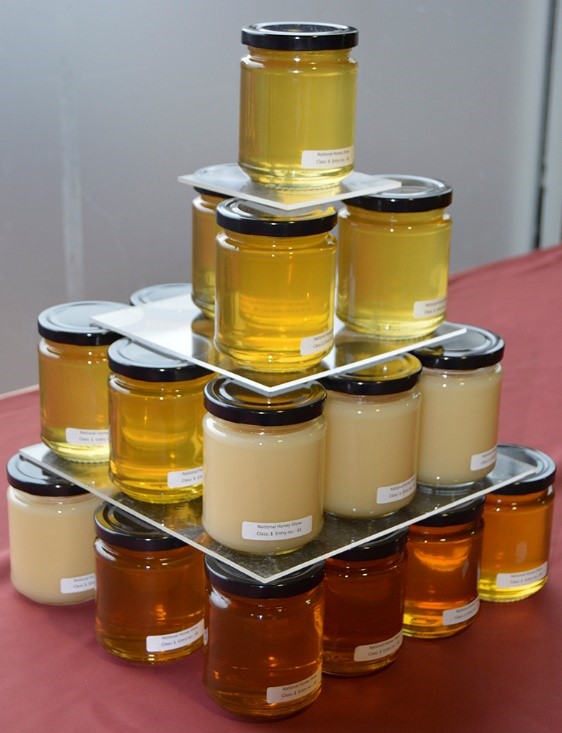 ney Show this October, and to invite you to join us.
ney Show this October, and to invite you to join us.
A Show Schedule of classes, specially adapted for the 2021 show, will be published on our website mid-June.
We are, of course, aware that circumstances may change. We may have to adapt further to prevailing government and venue restrictions, but are of course hoping that this is worst case, and restrictions may be more relaxed for the show.
As things stand at the present, this will be the format for the October Show:
- Face masks mandatory except when eating or drinking
- One way system
- Maximum 1,000 people in the venue
We are keen to ensure the honey show and trade show take place safely, all within the large Surrey Hall as usual. But please bear with us should distancing and the one-way system still be in place.
We look forward to welcoming you to this year’s show.
Upcoming Events
Monmouth Bee Festival: 1st August
Scotland Sale Days: 13th – 14th August
Windsor Sale Day: 11th September
Stockbridge Sale Day: 25th September
Devon Sale Day: 2nd October
Rand Open Day: 9th October
National Honey Show: 21st – 23rd October
